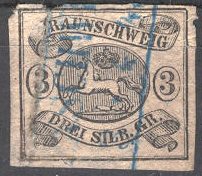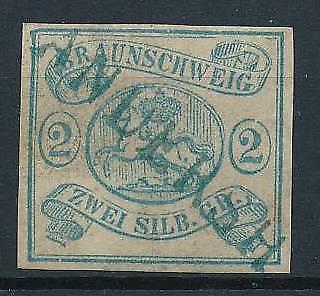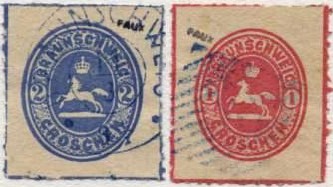 |
|||||
|
|||||
| Preview of Stamps Catalogue: VOLUME 1 |
 |
|||||
|
|||||
| Preview of Stamps Catalogue: VOLUME 1 |
Return To Catalogue - Brunswick Miscellaneous - forgeries of the 1852-64 issue, part 1 - forgeries of the 1852-64 issue, part 2 - Other German States- Germany
Note: on my website many of the
pictures can not be seen! They are of course present in the catalogue;
contact me if you want to purchase it.
One of the German States. A duchy in Germany. It issued stamps from 1852 to 1866. After 31st of December 1867 the stamps of Brunswick were no longer valid for use, the stamps of the North German Confederation were used afterwards.
1/4 Silb. Gr. (=3 Pfg) black on brown 1/3 Silb. Gr. (=4 Silbr. Pf.) black 1/2 Gr (=5 Pfennig) black on green 1 Silb. Gr. rose 1 Silb. Gr. black on yellow 1 Silb. Gr. yellow 2 Silb. Gr. black on blue 2 Silb. Gr. blue 3 Silb. Gr. black on red 3 Silb. Gr. vermilion or rose
The design of each value is slightly different from the other values. Some of these stamps exist rouletted:



Value of the stamps |
|||
vc = very common c = common * = not so common ** = uncommon |
*** = very uncommon R = rare RR = very rare RRR = extremely rare |
||
| Value | Unused | Used | Remarks |
No Watermark (1st January 1852) |
|||
| 1 sgr red | RRR | RR | Stamps issued 600,000. |
| 2 sgr blue | RRR | R | Stamps issued 600,000. |
| 3 sgr red | RRR | RR | Stamps issued 600,000. |
Watermark Posthorn |
|||
| 1/4 sgr black on brown | RRR | RR | Issued 1st March 1856; 271,040 stamps printed |
| 1/3 sgr black | RR | RR | imperforate. Issued 1st March 1856 An unofficial reprint exists without watermark. |
| 1/3 sgr black | RRR | RRR | rouletted |
| 1/2 sgr black on green | *** | *** | imperforate, issued 1st January 1863. Perforated stamps were made in Great Britain after they became invalid (source: H.Krotzsch, Illustrierter ausfuhrlicher Katalog uber Deutsche Postfreimarken) |
| 1/2 sgr black on green | RRR | RRR | rouletted; a stamp with perforation 12 is unofficially produced. |
| 1 sgr black on yellow | RR | *** | imperforate, issued 1st March 1853 First issued in yellowish-brown to brown-orange paper, in April 1861 printed on yellow paper instead. |
| 1 sgr black on yellow | RRR | RRR | rouletted |
| 1 sgr yellow | R | R | rouletted, issued July 1864 |
| 2 sgr black on blue | R | *** | Issued 1st March 1853 |
| 2 sgr black on blue | RRR | RR | rouletted |
| 3 sgr black on red | RRR | *** | Issued 1st March 1853 |
| 3 sgr red | RR | R | imperforate, issued September 1862 |
| 3 sgr red | RRR | RR | rouletted |
Many of the rouletted stamps are known to have been 'fabricated' from imperforate stamps.


(Two genuine stamps where the watermark 'Posthorn' can be seen at
the backside)
The 1 Sgr red, 2 Sgr blue and 3 Sgr vermilion were issued without watermark, all the others have watermark posthorn in a square which is clearly visible. Most forgeries and reprints can be detected by the absence of this watermark (except the three stamps mentioned above). The issues 1 Sgr red, 2 Sgr blue, 3 Sgr vermilion (all three without watermark, 1852) and the following stamps with watermark: 1 Sgr black on yellow (1853), 2 Sgr black on blue (1853), 3 Sgr black on red (1853), 3 Sgr rose (1863) and 1 Sgr yellow (1865) can be recognized by the following distinguishing characteristics (The Spud Papers XVII): the tail of the horse touches the third perpendicular line from the right side of the oval. The letters in the upper inscription are clear and seperate.
The genuine 1/2 Sgr, 1/3 Sgr and 1/2 Sgr are different from the other values. In the genuine 1/4 Sgr the crown is the same as in the higher values and there must be a dot behind 'PFENNIG'. In the genuine 1/3 Sgr the 'G' of 'BRAUNSCHWEIG' is quite close to the edge of the riband. The 1/2 Sgr genuine stamp finally has a wide crown (in some forgeries it is small), the right foreleg of the horse nearly touches the oval, the fractional line of '1/2' is small (not almost as wide as the oval containing it) and the ends of the lower riband are rather close to the frame.
For information on forgeries of the 1852-64 issue, click here for part 1 or here for part 2.
I have seen many different kinds of cancels, townname in a circle (black or blue) an arc, or in a rectangle:
Typical cancels:

Townname in an arc 'Halbkreis Ortsstempel'; also exist in blue
color.


Circular cancels, left without year indication (often in blue
color), right with year indication.


Circular cancel "WOLFFENBÜTTEL"


(Townname in a rectangle; "boxed postmark")

A special elliptic cancel from Holzminden (so-called
'Schnallenstempel')

Hammer cancel (Hammerstempel) from Gandersheim.

Unframed linear cancel (Balkenstempel), here
"GANDERSHEIM"

With an additional company cancel "G.M.BLECHSCHMIDDT
HOLZMINDEN"
Some stamps are cancelled with a numeral cancel (more information can be found on http://www.cwiakala.com/numerical.cancel.html ) or Michel Deutschland-Spezial-Katalog 1995 (Schwaneberger Verlag GmbH). They consists of 16 horizontal bars with a space left open in the center, where a number is placed (ranging from 1 to 50). Example:
The numbers stand for the following towns:
1 Badenhausen 2 Bahrdorf 3 Bevern 4 Blankenburg 5 Boden 6 Boerssum 7 Braunlage 8 Brunswick (Braunschweig, main post office) 9 Brunswick (Braunschweig railroad post office, two types; see Serrane guide) 10 Calvörde 11 Delligsen 12 Eschershausen 13 Fürstenberg 14 Gandersheim 15 Gittelde 16 Greene (up to 10 October 1865) or Naensen (from 10 October 1865 onwards) 17 Gross-Winnigstedt 18 Halle/Weser 19 Harzburg 20 Hasselfelde 21 Helmstedt 22 Hessen 23 Hohegeiss 24 Holzminden 25 Jerxheim 26 Immendorf (up to 31 December 1860) or Hehlen (from 1 November 1862 onwards) 27 Kl.-Rhüden (up to October 1864) or Bornum b. Seesen (from October 1864 onwards) 28 Königslutter 29 Kreiensen 30 Langelsheim 31 Lehre 32 Lutter/Bge. 33 Oker 34 Ottenstein 35 Rübeland 36 Salder (seems to exist with thick and thin bars, see Serrane guide) 37 Schoeningen 38 Schoeppenstedt 39 Seesen 40 Stadtoldendorf 41 Tanne 42 Thedinghausen 43 Vechelde 44 Velpke 45 Vorsfelde 46 Walkenried 47 Wolfenbüttel 48 Zorge 49 Mainzholzen (from 1 Aug 1857 to 10 October 1865) or Vorwohle (from 10 October 1865 onwards) 50 Braunschweig (seems to be very rare)
The numeral cancels can be found on all issues.
I have also seen these stamps cancelled with a penstroke.


Pencancel on the 2 sgr black on blue, besides a large penstroke
across the stamp, there are also two small penstrokes on the two
'2's on both sides. Next to it a 1 Sgr stamp with a similar
penstroke cancel.
An impression in a similar horse design was used on envelopes by Richard Borek; it has "RICHARD BOREK" instead of "BRAUNSCHWEIG" and "R B" instead of the numeral value indication. It has "BRAUNSCHWEIG" written in the bottom value label (where the value indicated in text normally is).
1/4 Silb. Gr. Black on brown
This stamp should have watermark 'Posthorn'. The same stamp printed in brown on white paper was never issued (this stamp was prepared, but Brunswick entered the North German Confederation before it could be issued).
Value of the stamps |
|||
vc = very common c = common * = not so common ** = uncommon |
*** = very uncommon R = rare RR = very rare RRR = extremely rare |
||
| Value | Unused | Used | Remarks |
| 4/4 ggr black on brown | ** | *** | |
| 4/4 ggr brown on white | ** | - | Unissued stamp, sold with the remainders in 1868. |
Howe to determine if this stamp is genuine?

(The ten distinguishing points of a stamp that I presume genuine)
Genuine stamps should have a watermark and (according to Distinguishing characteristcs of old german states by Schloss) and the following distinguishing characteristics (see pictures above and below for more details):



(distinguishing characteristics 1, 2, 3 and 4)



(distinguishing characteristics 5, 6 and 7)



(distinguishing characteristics 8, 9 and 10)
1) A dot behind the 'a' and 'r' in 'Postmarke' in
the left upper field.
2) The crown's left lower part is open in the right upper field.
3) The '1' of '1/4' of the right upper field has no top stroke
4) The '4' is broken at the foot in the right upper field
5) The second 'g' of 'Gutengr.' has a missing lower part
6) There is a dot behind the 'a' of 'Postmarke' in the right
lower field
7) A period can be found behind 'Postmarke' in the right bottom
8) The 'P' of 'Postmarke' in the lower right field touches the
central frame line
9) The 'f' of 'Pfennige' in the lower left field extends across
the inner frame line
10) Two dots can be found behind and in front of the 's' of
'Postmarke' in the left upper field.




Forged stamps in brown and black made by the same forger. The
fraction bars of the '1/4' are not supposed to touch the ovals.
Also note that the dot behind the lower right 'Gutengr' is placed
too far to the right. The second forgery seems to have a French
'1104' blue numeral cancel (this cancel is also mentioned in the
Serrane guide for forgeries of the first issue). I've also seen
this forgery with a French '6021' cancel in black. I've been told
that this forgery might have been made by Zechmeyer.




Forgery which I have been told was made by the forger Young. Note
the very large space between "Gute" and "gr".
The design of this forgery is identical to the image given in
"The illustrated catalogue of postage stamps" by
J.E.Gray (1870, page 13, see second image). A similar image
appears in the catalogue of Placido Ramon
de Torres "Album Illustrado para Sellos de Correo"
of 1879, page 34 (information passed to me thanks to Gerhard
Lang, 2016). So either this forgery was inspired by the de Torres
catalogue, or de Torres copied an image of a forgery into his
catalogue.

Forgery based on an image of the Moens catalogue

I've been told this forgery was made by Kossak(?).

I've been told this forgery was made by Senf.

Another forgery with very different crowns
Forged cancels can be found on the genuine 4/4 g black stamp. Any cancels on the 4/4 g brown stamps must be forged (since it was never issued). Even chemically changed brown stamps turned into black stamps exist (see Serrane guide).
1/3 Gr. black 1 Gr. red 2 Gr. blue 3 Gr. brown
These stamps are rouletted, the horse is embossed. They were printed in sheets of 100 stamps (10 rows of 10 stamps). The (many) remainders were sold in 1868. A non-official reprint of the 1 g and 2 g stamps exist on shiny paper without perforation. Some sheets with imperforate remainders also exist of all values (RR). The 1 g, 2 g and 3 g were issued in colors corrresponding to the German-Austrian Postal Union convention.


Pairs of imperforate remainders of the 1/3 g and 1 g stamps
Value of the stamps |
|||
vc = very common c = common * = not so common ** = uncommon |
*** = very uncommon R = rare RR = very rare RRR = extremely rare |
||
| Value | Unused | Used | Remarks |
| 1/3 g | ** | RR | |
| 1 g | c | ** | Used bisected: RRR |
| 2 g | ** | *** | Used bisected: RRR |
| 3 g | * | *** | |
Forgeries exist of these stamps. For example the forger Fournier offered all 4 values as first choice forgeries in his 1914 pricelist for 2 Swiss Francs. According to the Serrane guide the mane and tail are different. Also note the colored border in the next forgeries:

Fournier forgeries of the 1 g and 2 g values, reduced sizes. The
left stamp has the 'BRAUNSCHWEIG 11 3 9 1/2' cancel. The right
stamp probably a forged numeral '8' cancel.

Unfinished Fournier forgery of the 3 g as taken from 'The
Fournier Album of Philatelic Forgeries' (reduced size).

Forged Fournier cancels.
Forged cancels on genuine stamps:
Many of these stamps have a forged postmark as the stamp shown above; the used stamps are many times more valuable.

Another forged cancel, image obtained from
http://www.bdph.de/forum/showthread.php?t=4063. The genuine
cancel is a square consisting of lines.

Some 'saving' stamps in a similar design, inscrption
"BRAUNSCHWEIG SPARGROSCHEN"
Briefmarken - Stamps - Timbres-Poste